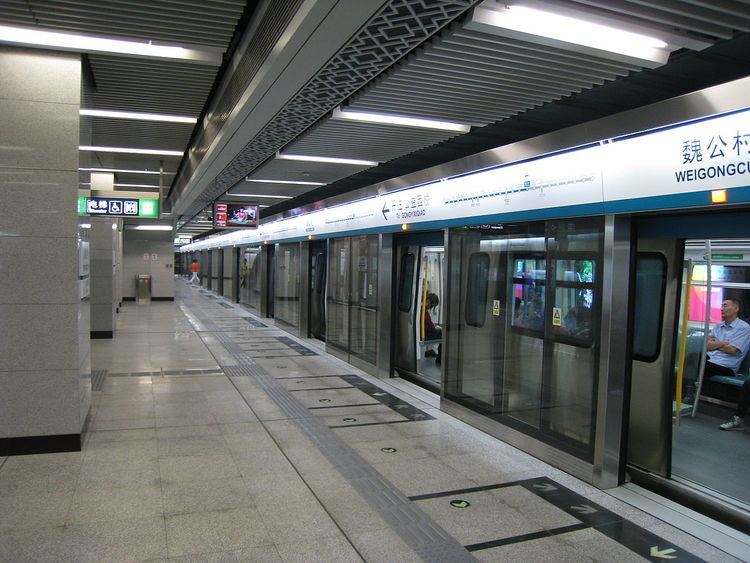Type Rapid transit Status Operational | System Beijing Subway Stations 24 | |
 | ||
Locale Haidian, Xicheng & Fengtai Termini Anheqiao North
Gongyixiqiao | ||
Line 4 of the Beijing Subway (Chinese: 北京地铁四号线; pinyin: běijīng dìtiě sìhào xiàn) is the 9th subway line in Beijing's mass transit network. It entered into operation on September 28, 2009, and runs from north to south, parallel and to the west of Line 5, through Haidian, Xicheng, and Fengtai Districts in the western half of the city. It is 28.2 km long with 24 stations. Riding on this line starts from a fare of RMB(¥) 3.00 depending on the distance travelled. Line 4's color is teal.
Contents
- Hours of operation
- Route
- Service routes
- List of Stations
- Planning and construction
- Operation
- Future development
- References
Line 4 and Daxing Line operate as a single line although they are classified as separate lines.
Hours of operation
The first south-bound trains departs from Anheqiao North at 5:00am. The first north-bound train departs from Gongyixiqiao at 5:10am. The last north-bound train leaves Anheqiao North at 10:45pm. The last south-bound train leaves Gongyixiqiao at 11:10pm. Each train completes the entire journey in 48 minutes.
Route
In the north, Line 4 begins in Anheqiao, just beyond the Summer Palace and heads south past the Old Summer Palace, through the university district and Zhongguancun, Beijing's high-tech silicon village, before turning east at the National Library of China and passing the Beijing Zoo en route to Xizhimen. After entering the 2nd Ring Road at Xizhimen, Line 4 resumes southwards at Xinjiekou and traverses the old city through Xisi, Xidan, Xuanwumen, Caishikou, and Taoranting Park. It passes the city's high-speed rail link at the Beijing South Railway Station before reaching the terminus at Gongyixiqiao. Construction began 2004 but delays have pushed back the opening date by two years to September 28, 2009.
Service routes
List of Stations
The following is the list of stations, from north to south (with transfer points* to other lines):
Planning and construction
Plans for Line 4 date back to the 1950s when Beijing's first subway line was still under construction. It was planned to run from the Summer Palace, east towards Xizhimen, southeast to Zhongshan Park, terminating at the Beijing Stadium, which near today's Tiantandongmen Station. Ultimately, the section between Summer Palace to Xizhimen was built as planned. However, construction only formally started in 2004.
On December 3, 2004 Hong Kong's MTR Corporation, Beijing Infrastructure Investment Co., Ltd., and Beijing Capital Group Co., Ltd. signed the Beijing Metro Line 4, investment, construction, operation principle of cooperation agreement, making Line 4 the Mainland China's first rail transit line financed using a public-private partnership framework. Subsequently, on November 8, 2005, a Joint Venture between the 3 companies was established. The Hong Kong MTRC will invest 735 million RMB to the construction of Line 4 and in return have the right to operate Line 4 for 30 years.
On February 11, 2009, the construction of Line 4 is nearing completion with all tunnels bored. In March 6, four subway trains begin testing while Hong Kong's then Chief Executive, Donald Tsang, visited the project. On September 28, 2009, Beijing Subway Line 4 is officially opened for trial operation. Bringing the number of subway lines in Beijing to 9. On December 30, 2010, the Daxing Line started trial operation, with direct service into Line 4. Creating a 35 station 50 km long line.
Operation
Unlike the other lines of the Beijing Subway, which are completely state-owned and operated, Line 4 was built and is managed by the Beijing MTR Corp. Ltd., a three-way joint-venture among the Hong Kong MTR Corporation, the Beijing Capital Group ("BCG"), and the Beijing Infrastructure Investment Co. ("BIIC"). The Hong Kong MTR, which operates the Hong Kong Mass Transit Railway, and the state-owned BCG each holds a 49% stake in the venture and the BIIC has 2%. The JV is responsible for 30% of the investment capital to build Line 4, mainly to finance the purchase of electrical and mechanical equipment, while the Beijing Municipal Government provided the remaining 70%, to cover civil engineering, station, and track work costs.
The Beijing government has also awarded the JV a concession to manage Line 4 for 30 years. The PPP JV model was designed to introduce private capital as well as advanced metro management methods to the growing Beijing Subway. Among the most visible differences in management of Line 4 is a ban on food and beverage consumption inside Line 4 trains and stations. No such ban exists for other Beijing subway lines, except for Line 16, which is also operated by the JV.
Future development
Planners in Haidian District have proposed extending the line to the north by 8 km with four additional stations. The planned stations have been identified as Baiwangshan (百旺山), Xibeiwang (西北旺), Aerospace City West (航天城西), and Yongfeng (永丰站). The extension remains in the planning stages as there are no plans to build it yet. However, according to the June 2010 plans, Line 4’s northern extension will be replaced by the northern extension of Line 16 opening in 2016.
